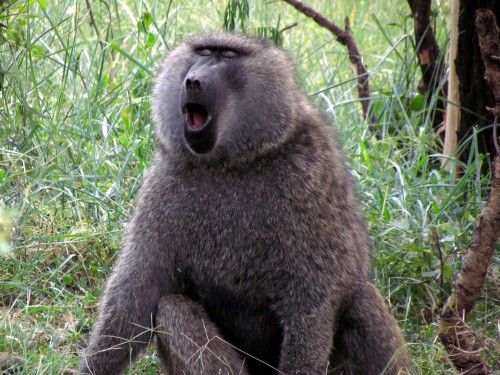
 When lions and leopards are absent, baboons change their behavior, which affects the food web and humans alike.
When lions and leopards are absent, baboons change their behavior, which affects the food web and humans alike.
Eight-foot tall, 2000-pound California grizzlies once roamed the river valleys of California, but they were hunted to extinction nearly a century ago. In sub-Saharan Africa, lions and leopards are declining. In North America, wolves have disappeared from most of the American West; mountain lions are extinct in the eastern United States. Around the world, predators are not what they once were. Justin Brashares and Mary Power, biology professors at UC Berkeley, and colleagues have used combined research from otters, wolves, lions, and trout, to collectively pursue a pressing question: what happens in nature when predators at the top of the food chain become scarce?
Throughout the living world, animals and plants can be divided into levels based on their energy source, comprising a network known as a food web. Living things on the lowest level, such as plants and algae, produce energy from sunlight. Creatures on higher levels get energy by devouring things on lower ones, and thus energy moves from the bottom up. Brashares and Power study phenomena moving in the opposite direction, from the top down. Using a long-standing concept called a trophic cascade (trophos means “nourishment” in Greek), Power and Brashares study the effects of changes at the top of the food web on the lower levels. To visualize a trophic cascade, picture a waterfall cascading in stepwise fashion down a rocky slope. The impact of the water at each step is determined by what is happening at the levels above. Slow the flow of water at the top to a trickle, and the steps below will eventually dry out. Power, Brashares, and their colleagues have found that the effects of trophic cascades are present in land, sea, and river ecosystems, and can have important consequences for humans.
In rivers, Power investigates trophic cascades by designing field experiments. In a series of studies, Power directly manipulated river food webs by using netting to establish sections of rivers that excluded or included top predators, which, in this case, were steelhead trout. Despite the logistical challenges of setting nets in unpredictable running water, Power maintains that “to best explain the patterns in nature, you need to study the processes in nature.” Excluding predators from some portions of a river, while allowing them in others, produced dramatic cascades. When present, steelhead trout preyed on smaller fish, decreasing their numbers. With fewer small fish, aquatic insects flourished and gorged themselves on algae. When top predators were removed, the cascade had the opposite sequence of effects, leaving diminished insect populations and large, intact mats of algae.
For lions and leopards, where enclosures are impractical, Brashares uses behavioral observations and well-placed cameras to study populations over time. In northern Ghana, where Brashares works with a team from the Ghana Wildlife Division, hunting has decreased lion and leopard populations, allowing populations of olive baboons to balloon. With fewer lions and leopards, baboons spent less time in trees, and more time hunting small monkeys, whose populations declined. The rise of baboons demonstrates a classic consequence of predator decline: when the top predators disappear, mesopredators (medium-level predators) become the new top rung of the food web ladder. Similarly, in North America, fewer wolves and mountain lions has led to the rise of mesopredator coyotes.
Brashares’ recent research has also demonstrated that, in some cases, predator declines have direct consequences for humans. For example, baboons and humans share many pathogens and parasites. The increase in baboon numbers led to more frequent contact between baboons and human communities. As the frequency of interaction increased, local health workers found that intestinal parasites became more common in humans. Baboons are further problematic because they destroy crops and prey on livestock, harming food supplies. If larger populations of baboons become the new normal, they may elevate risks for human disease and crop destruction in these regions.
Both researchers stress that “the impacts of trophic cascades are context-dependent.” Environmental conditions and the biological makeup of food webs differ in different systems; therefore, conclusions from these studies do not always lead to broad general trends that can be universally applied. Even so, Power and Brashares’ research demonstrates the potential consequences to both humans and wildlife of a continued decline in top predators. These findings are timely, given that three-quarters of the world’s large carnivores have declining populations. As Brashares puts it, “Large animals at the top of food webs are not just icing on the cake. Their presence helps determine the quality of the cake itself.”
This article is part of the Spring 2014 issue.



